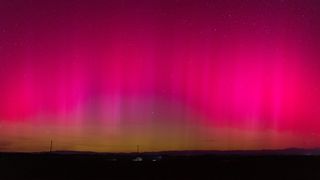Auroras could paint Earth's skies again in early June. Here are the key nights to watch for.
The monster sunspot responsible for May's vibrant auroras will be facing Earth again in a matter of days, and it still appears to be active. Here's when to be alert for the next display of northern lights on the nights close to June's new moon.

If you want to glimpse the northern lights from below the Arctic Circle, be ready to drive to dark skies the first week of June.
Earth's most powerful geomagnetic storm in more than two decades happened between May 10 and May 12, painting the skies with colorful auroras as far south as Florida and Mexico in an ultra-rare occurrence.
This was the result of at least five solar storms that hit Earth simultaneously, all originating from a massive sunspot known as active region 3664 (also called AR3664 and AR13664), a dark patch on the sun more than 15 times wider than Earth. The barrage of charged particles collided with Earth's magnetosphere, which funneled them along magnetic field lines toward the poles, generating vibrant auroras along the way.
Crucially, the fallout from the solar storms arrived a few nights after May's new moon, when the night sky was free from moonlight — making even faint auroras easier to see.
Because the sun rotates on its axis once every 27 days, the sunspot disappeared from view around a week later, but it didn't stop producing solar flares. On May 20, it emitted a solar flare rated as X12, the strongest since September 2017. It was observed by the European Space Agency's Solar Orbiter spacecraft.
AR3664/AR13664 is now becoming visible again as the sun rotates — and it will be Earth-facing once again during the new moon on June 6.
"It will align nicely," Ryan French, a solar physicist at the National Solar Observatory (NSO) in Boulder, Colorado, told Live Science. "As soon as the sunspot starts to appear, we will enter the window of opportunity [for solar flares]."
Sign up for the Live Science daily newsletter now
Get the world’s most fascinating discoveries delivered straight to your inbox.
Related: 32 stunning photos of auroras seen from space
The monster sunspot will reappear in late May/early June, but when the sunspot reaches just to the right of the center of the sun, from our perspective, the sun-Earth system will be most connected. That's when our planet is most likely to be hit by solar weather, potentially resulting in another display of auroras at low latitudes.
"That's exactly where it produced all of those large flares," said French. "But in theory, if you had a large enough eruption, even if it's just to the left of the sun's center, we could still get the edge of that impact."
June 6's new moon rises exactly 27 days after May 10, so be on alert a few nights before and after that date — just in case there's a repeat of last month's extreme geomagnetic activity. If auroras are visible near you, you'll need to get far from obscuring clouds and city lights to be able to see them.
Even after June's new moon, there may still be other chances to catch the aurora near you this year. Sunspots appear in greater frequency — and trigger more powerful solar flares — during the peak of the sun's 11-year activity cycle, known as the solar maximum. Scientists suspect that the current cycle's maximum may already be underway, hitting us sooner and harder than previously estimated. But we won't be able to determine the maximum's precise timing until after it ends, and solar activity finally quiets down again.
Update: This article was updated on May 29 to specify where to look for the sunspot after it reappears. It will be just to the right of the sun's center.
Jamie Carter is a freelance journalist and regular Live Science contributor based in Cardiff, U.K. He is the author of A Stargazing Program For Beginners and lectures on astronomy and the natural world. Jamie regularly writes for Space.com, TechRadar.com, Forbes Science, BBC Wildlife magazine and Scientific American, and many others. He edits WhenIsTheNextEclipse.com.
Most Popular

